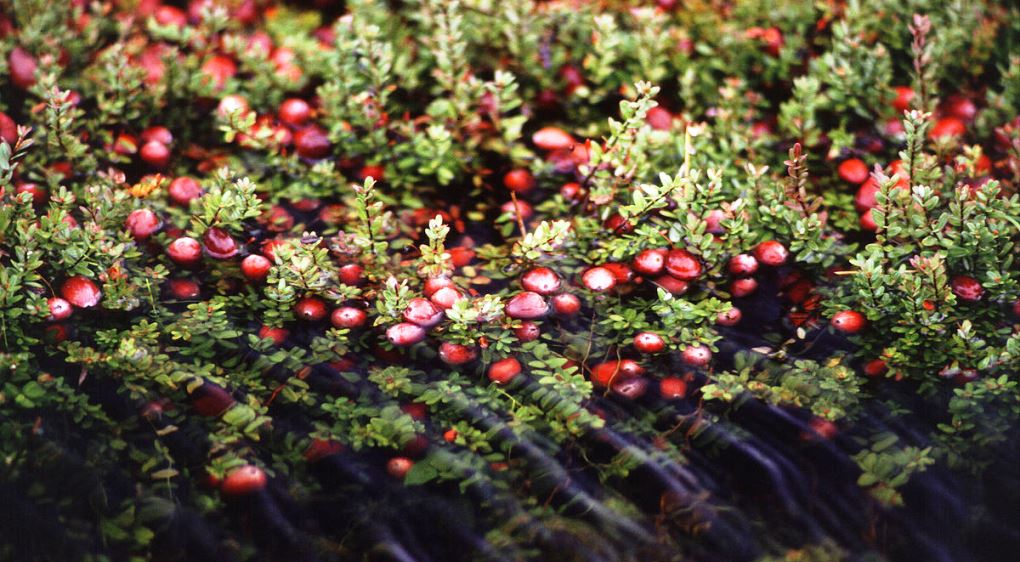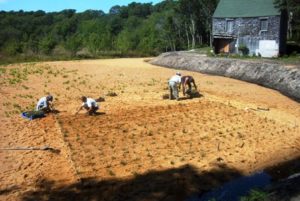In Vineyard Haven on Martha’s Vineyard, Massachusetts, the Vineyard Open Land Foundation (VOLF) is a non-profit that has been revitalizing a commercial cranberry bog.
Bogs (usually located in kettle holes) were once a common sight around the Vineyard. This one was built in the 1880s, but by the 1970s it was abandoned and turned into a campground.
Eric Peters is the chairman of the board. “We’ve really restored the ecosystem that was here that’s an agricultural ecosystem. It is cranberries but we’ve also been doing it organically,” he said.
They only use organic fertilizers and no pesticides. The non-profit started replanting this cranberry bog in 2004. It’s been a long process and one that really did take a village.
The bog is located on 23 acres of conservation land owned by VOLF adjacent to the Mary P. Wakeman Conservation Center. The bog consists of 2.5+ acres and three reservoir ponds.
The project objectives of the project are:
- Serve as a demonstration facility for growing cranberries on an environmentally friendly basis;
- Demonstrate the viability, economic and agricultural, of the bog;
- Grow high quality cranberries for the market; and
- Provide a source of funds to support VOLF.
PHASE ONE was the planning and permitting state, which was accomplished in early 2004. The project has received support from many technical and governmental organizations. Several Island professionals are donating their time to assist in moving the project forward.
PHASE TWO is the restoration of the bog and the water control structures to support organic growing methods. A one-quarter acre portion of the bog was cleared and sanded in 2004. VOLF is currently in the process of applying for permits to install an irrigation system and is fund-raising for other work in 2005.
PHASE THREE is the reconstruction of the cranberry processing shed and the development of the demonstration area. The goal is to provide a learning resource for environmentalists, biologists, bog owners and tourists and to demonstrate the organic growing of cranberries.
PHASE FOUR is to promote the feasibility of ecologically sustainable cranberry bogs as working demonstrations that integrate protection for wetlands and organic production of cranberries.
Cranberries are a group of evergreen dwarf shrubs or trailing vines in the subgenus Oxycoccus of the genus Vaccinium. In Britain, “cranberry” may refer to the native species Vaccinium oxycoccos, while in North America, “cranberry” may refer to Vaccinium macrocarpon. Vaccinium oxycoccos is cultivated in central and northern Europe, while Vaccinium macrocarpon is cultivated throughout the northern United States, Canada and Chile. They are found wild in acidic bogs throughout the cooler regions of the Northern Hemisphere.
Cranberries are low, creeping shrubs or vines up to 2 meters (7 ft) long and 5 to 20 centimeters (2 to 8 in) in height. They have slender, wiry stems that are not thickly woody and have small evergreen leaves. The flowers are dark pink, with very distinct reflexed petals, leaving the style and stamens fully exposed and pointing forward. They are pollinated by bees. The fruit is a berry that is larger than the leaves of the plant; it is initially light green, turning red when ripe. It is edible, but with an acidic taste that usually overwhelms its sweetness.
In 2016, 98% of world production of cranberries resulted from the United States, Canada, and Chile. Most cranberries are processed into products such as juice, sauce, jam, and sweetened dried cranberries, with the remainder is sold fresh to consumers.
Featured photo of cranberry bog by Keith Weller.


